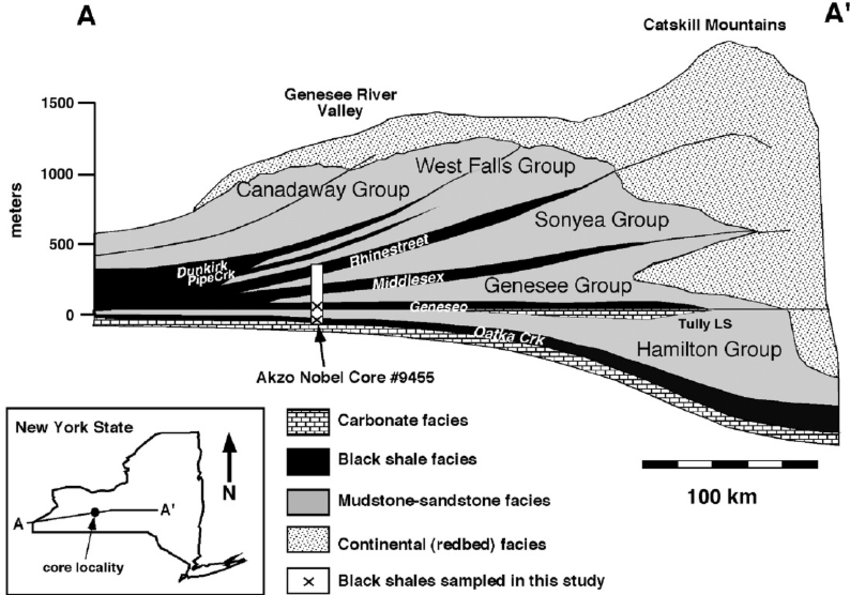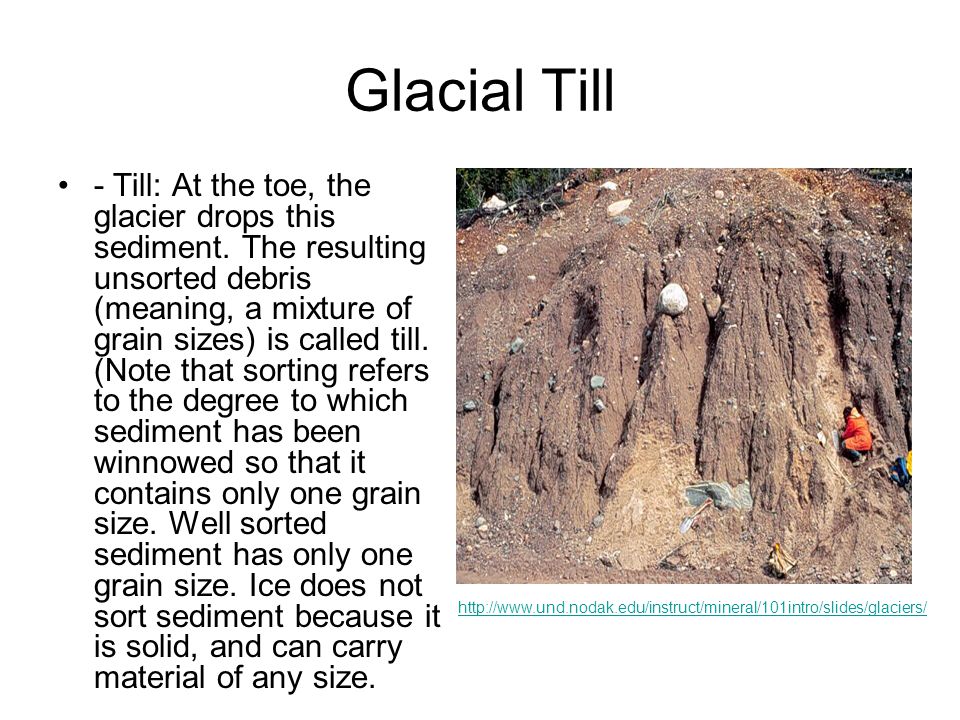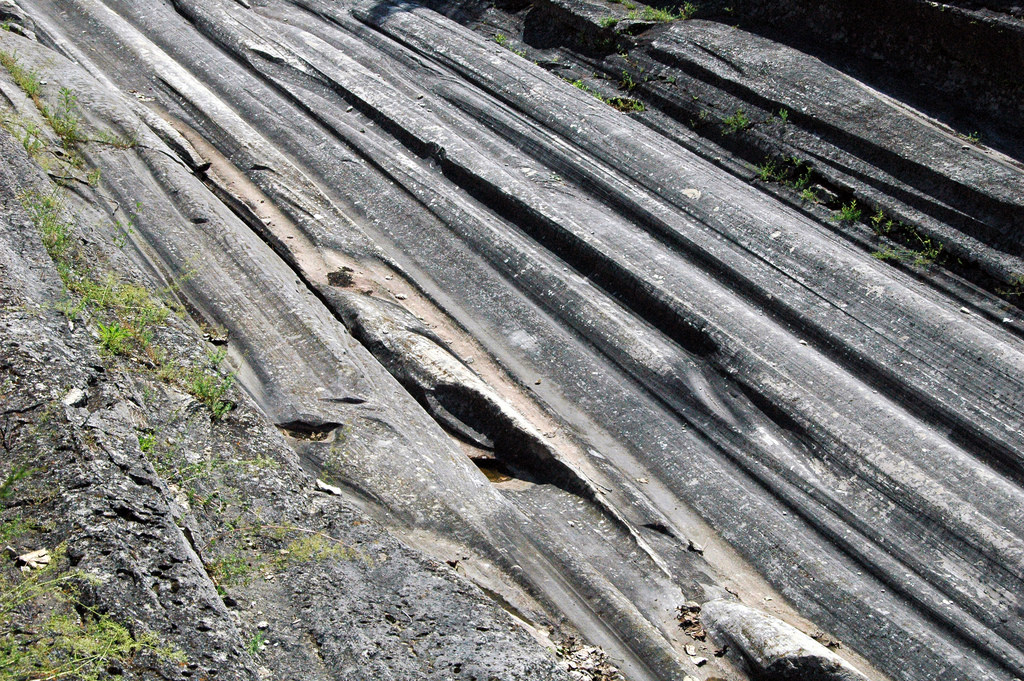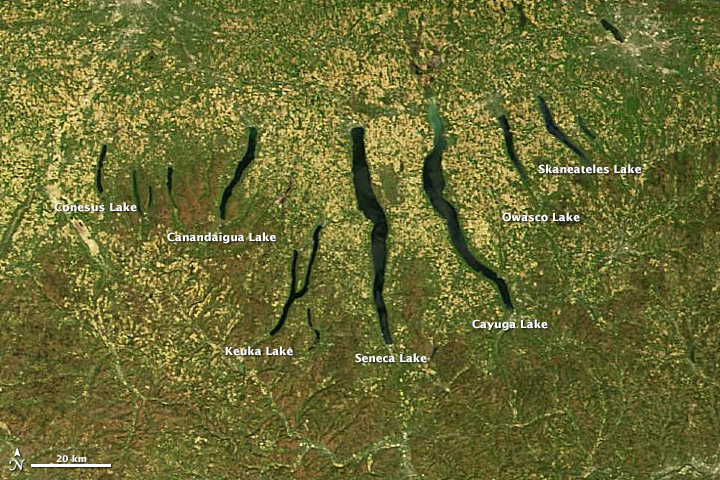- Jun 15, 2017
- 9,672
- 3,266
- Country
- United States
- Gender
- Male
- Faith
- Christian
- Marital Status
- Married
- Politics
- US-Republican
I figured I would make a thread on the geology of New York, to see what Young Earth Creationists might think.
The discussion begins with the diagram below.

Genesee Group (NYDg;4)
Sonyea Group (NYDs;5)
Angola and Rhinestreet Shales (NYDwf;4)
Machias Formation (NYDcy;4)
At the base, limestone. Limestone largely consisting of microscopic carbonaceous shells. Derived from deep sea shelled organisms. These are rocks formed at great depths.
Dark carbonaceous shales (identified in the figure as black shale facies) are rich in organics. Formed in anoxic environments without oxygen for decomposition. With higher amounts of organic material, shales take on a dark black color. With less oxygen, oxygen poor environments yield precipitation of sulfide minerals.
These dark shales form in an environment also of a deep sea, but with influence from nearby deposition of sediment.
Above the black shale facies are mudstone-sandstone facies. Shales again, but with higher oxygen content. Shallow waters allow for circulation of oxygen forming minerals like hematite (FeO2) and Magnetite (FeO3). The rocks take on a lighter hue. Sandstones, formed in shallow marine and terrestrial environments (much like the sandy beaches of today).
These are the rocks of shallow marine and a terrestrial beach like environment.
Above these rocks still, the Catskill Devonian red beds. Highly oxidated. Lithologies found in fining upward sequences with turbidites, sorted by density, with conglomerates (rocks formed in tumbling depositional environments).
-----------------------------------------------------
Collectively, we have 5 groups of rock, each group having the sequence of rocks above.
Beyond that further, atop the Devonian shale is glacial till (unsorted, not deposited by water), glacial moraines, drop stones, glacial striations, lakes in a north to south direction (carved by glaciers moving in a north to south direction)
These are traits of Pleistocene ice ages.



--------------------------------------------------------------
Uniformitarianism has a simple explanation. The Acadian Orogeny.
As continental crust advances from the ocean in a western direction into what was then central america, mountain ranges are eroding, depositing sediment. Deltas form along the mountain range. Sea level rises, deeper waters give rise to anoxic carbonaceous shales. Sea level drops, the sea becomes aerated, more oxidized minerals form, rocks change color and chemistry.
Fast forward to the pleistocene epoch, ice comes down from the north, carves the great lakes and finger lakes, then deposits unsorted glacial till as it melts away.
https://www.youtube.com/watch?v=9smM0VjTJBg
And the fossils match. No dinosaurs in NY as the rocks are twice as old as the earliest dinosaurs. No mammals, no birds. Tetrapods are present (as predicted, tetrapods are of the devonian period). No bunny rabbits. Just devonian tetrapods and fish.
--------------------------------------------------------------
How could such a complex geology ever be explained as something to have formed within 6000 years?
The discussion begins with the diagram below.

Genesee Group (NYDg;4)
Sonyea Group (NYDs;5)
Angola and Rhinestreet Shales (NYDwf;4)
Machias Formation (NYDcy;4)
At the base, limestone. Limestone largely consisting of microscopic carbonaceous shells. Derived from deep sea shelled organisms. These are rocks formed at great depths.
Dark carbonaceous shales (identified in the figure as black shale facies) are rich in organics. Formed in anoxic environments without oxygen for decomposition. With higher amounts of organic material, shales take on a dark black color. With less oxygen, oxygen poor environments yield precipitation of sulfide minerals.
These dark shales form in an environment also of a deep sea, but with influence from nearby deposition of sediment.
Above the black shale facies are mudstone-sandstone facies. Shales again, but with higher oxygen content. Shallow waters allow for circulation of oxygen forming minerals like hematite (FeO2) and Magnetite (FeO3). The rocks take on a lighter hue. Sandstones, formed in shallow marine and terrestrial environments (much like the sandy beaches of today).
These are the rocks of shallow marine and a terrestrial beach like environment.
Above these rocks still, the Catskill Devonian red beds. Highly oxidated. Lithologies found in fining upward sequences with turbidites, sorted by density, with conglomerates (rocks formed in tumbling depositional environments).
-----------------------------------------------------
Collectively, we have 5 groups of rock, each group having the sequence of rocks above.
Beyond that further, atop the Devonian shale is glacial till (unsorted, not deposited by water), glacial moraines, drop stones, glacial striations, lakes in a north to south direction (carved by glaciers moving in a north to south direction)
These are traits of Pleistocene ice ages.



--------------------------------------------------------------
Uniformitarianism has a simple explanation. The Acadian Orogeny.
As continental crust advances from the ocean in a western direction into what was then central america, mountain ranges are eroding, depositing sediment. Deltas form along the mountain range. Sea level rises, deeper waters give rise to anoxic carbonaceous shales. Sea level drops, the sea becomes aerated, more oxidized minerals form, rocks change color and chemistry.
Fast forward to the pleistocene epoch, ice comes down from the north, carves the great lakes and finger lakes, then deposits unsorted glacial till as it melts away.
And the fossils match. No dinosaurs in NY as the rocks are twice as old as the earliest dinosaurs. No mammals, no birds. Tetrapods are present (as predicted, tetrapods are of the devonian period). No bunny rabbits. Just devonian tetrapods and fish.
--------------------------------------------------------------
How could such a complex geology ever be explained as something to have formed within 6000 years?

